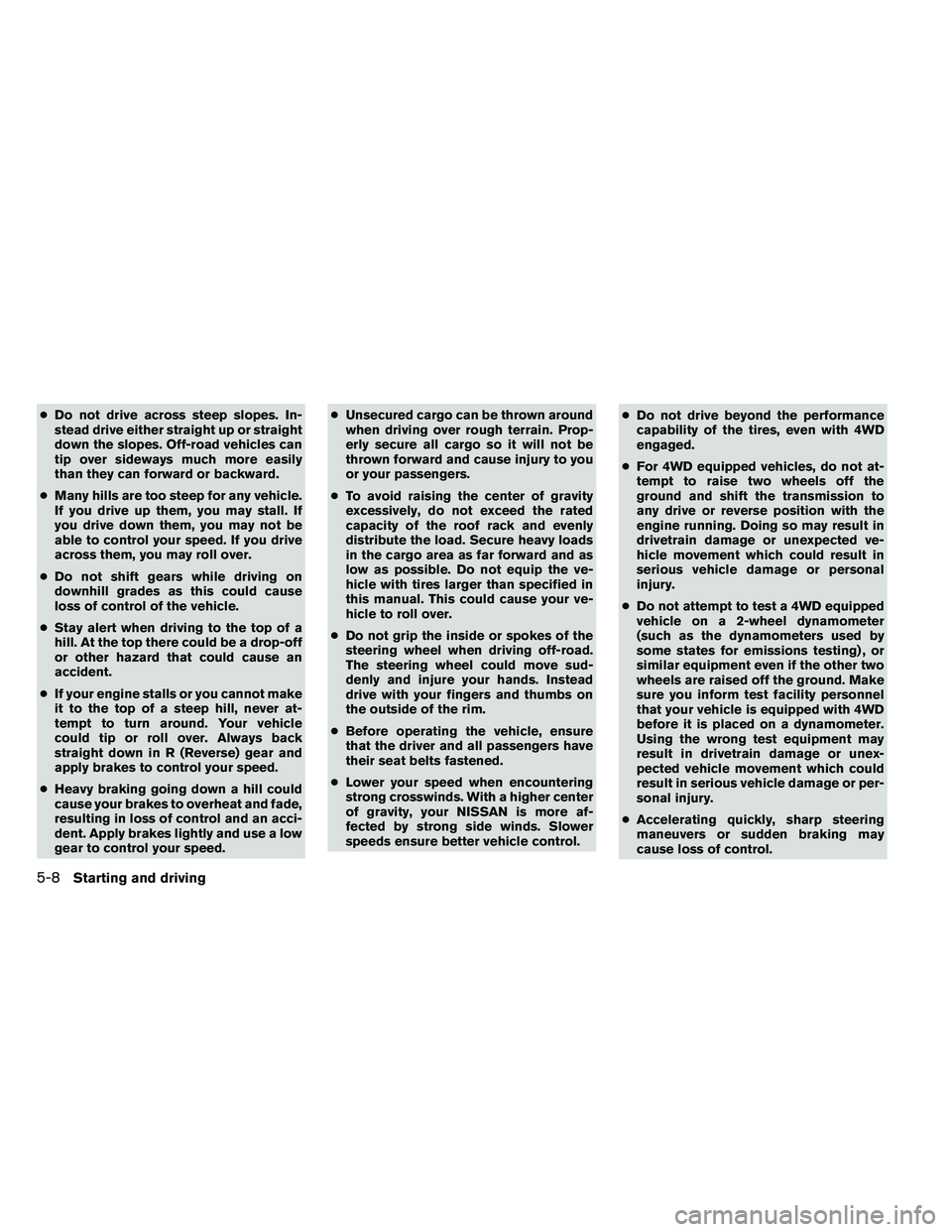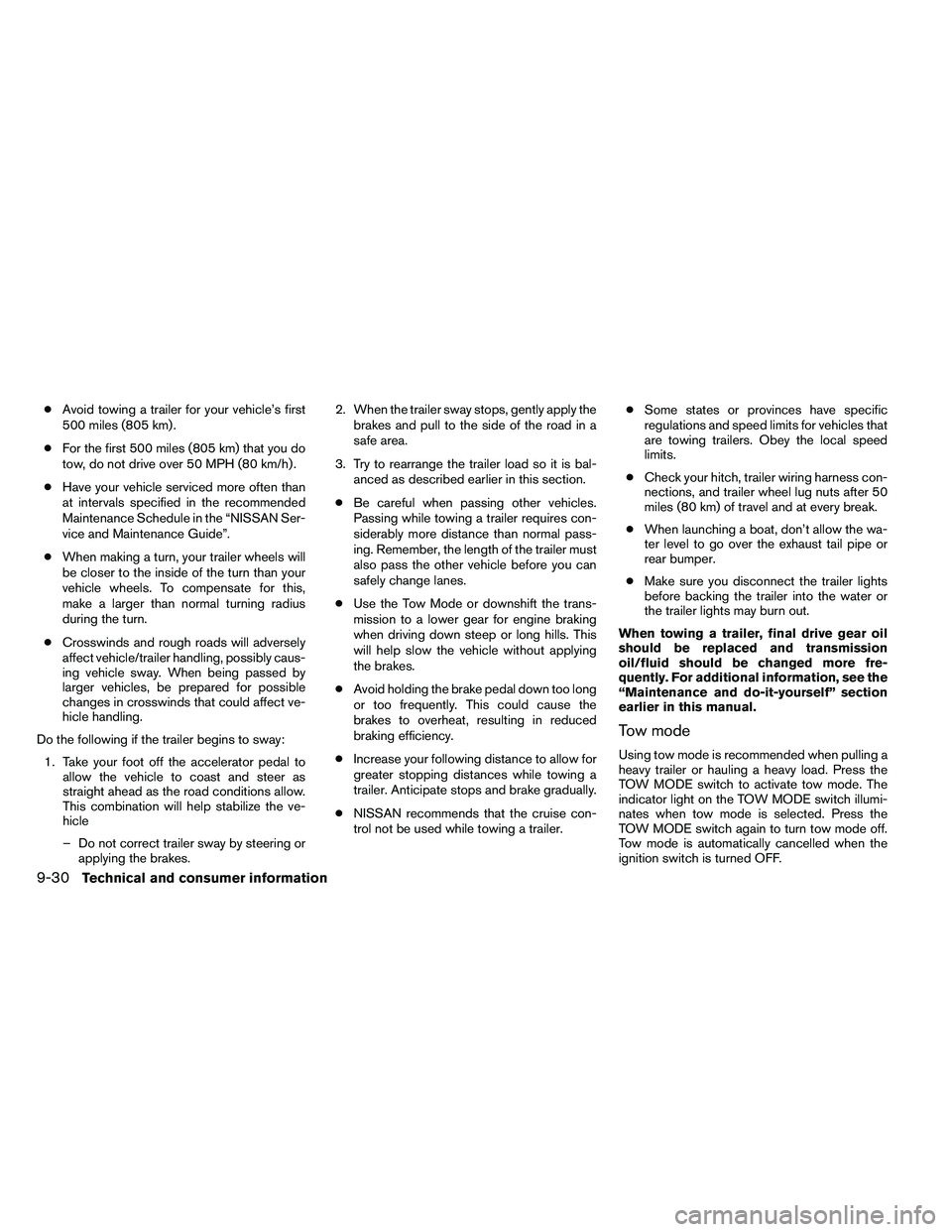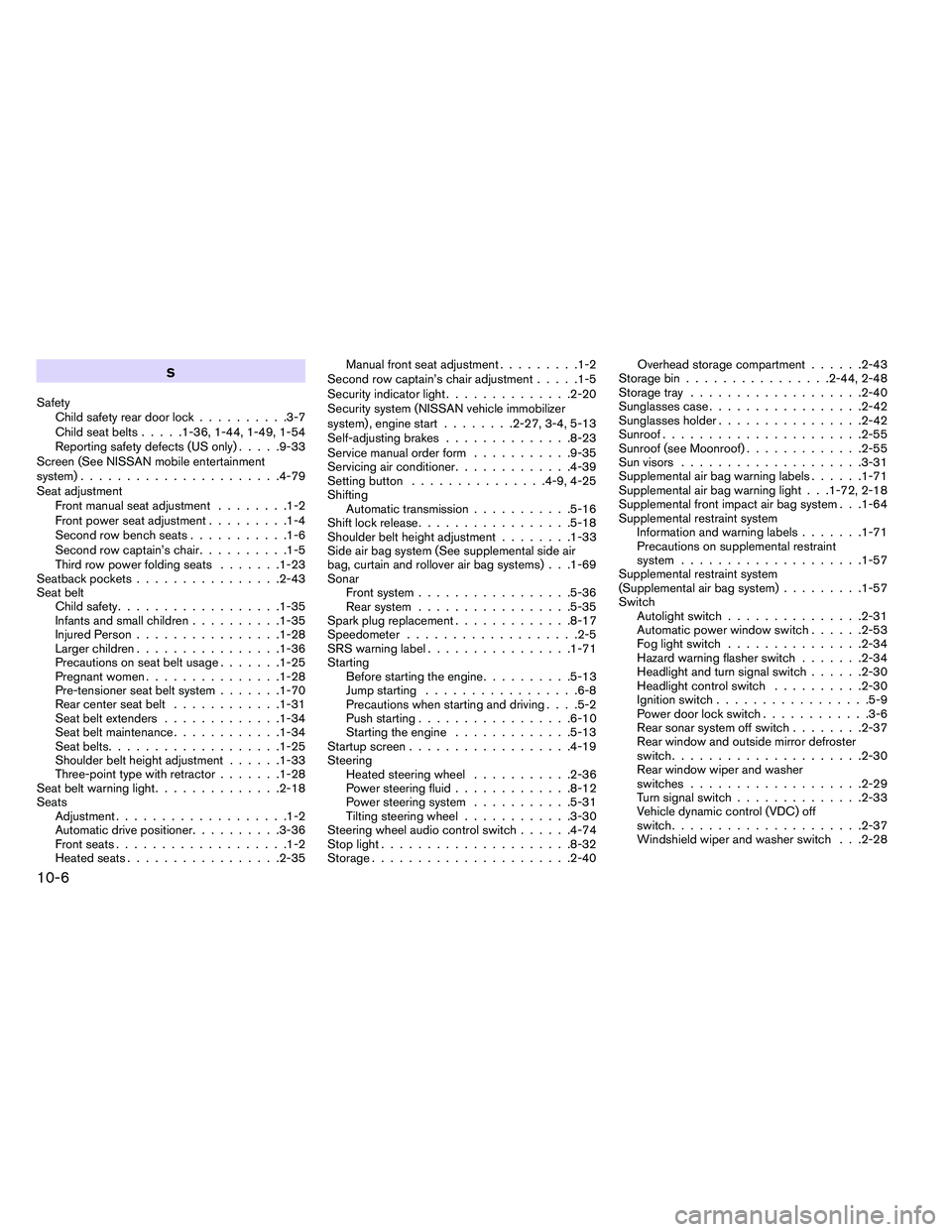2011 NISSAN ARMADA PLATINUM manual transmission
[x] Cancel search: manual transmissionPage 345 of 489

●Do not drive across steep slopes. In-
stead drive either straight up or straight
down the slopes. Off-road vehicles can
tip over sideways much more easily
than they can forward or backward.
● Many hills are too steep for any vehicle.
If you drive up them, you may stall. If
you drive down them, you may not be
able to control your speed. If you drive
across them, you may roll over.
● Do not shift gears while driving on
downhill grades as this could cause
loss of control of the vehicle.
● Stay alert when driving to the top of a
hill. At the top there could be a drop-off
or other hazard that could cause an
accident.
● If your engine stalls or you cannot make
it to the top of a steep hill, never at-
tempt to turn around. Your vehicle
could tip or roll over. Always back
straight down in R (Reverse) gear and
apply brakes to control your speed.
● Heavy braking going down a hill could
cause your brakes to overheat and fade,
resulting in loss of control and an acci-
dent. Apply brakes lightly and use a low
gear to control your speed. ●
Unsecured cargo can be thrown around
when driving over rough terrain. Prop-
erly secure all cargo so it will not be
thrown forward and cause injury to you
or your passengers.
● To avoid raising the center of gravity
excessively, do not exceed the rated
capacity of the roof rack and evenly
distribute the load. Secure heavy loads
in the cargo area as far forward and as
low as possible. Do not equip the ve-
hicle with tires larger than specified in
this manual. This could cause your ve-
hicle to roll over.
● Do not grip the inside or spokes of the
steering wheel when driving off-road.
The steering wheel could move sud-
denly and injure your hands. Instead
drive with your fingers and thumbs on
the outside of the rim.
● Before operating the vehicle, ensure
that the driver and all passengers have
their seat belts fastened.
● Lower your speed when encountering
strong crosswinds. With a higher center
of gravity, your NISSAN is more af-
fected by strong side winds. Slower
speeds ensure better vehicle control. ●
Do not drive beyond the performance
capability of the tires, even with 4WD
engaged.
● For 4WD equipped vehicles, do not at-
tempt to raise two wheels off the
ground and shift the transmission to
any drive or reverse position with the
engine running. Doing so may result in
drivetrain damage or unexpected ve-
hicle movement which could result in
serious vehicle damage or personal
injury.
● Do not attempt to test a 4WD equipped
vehicle on a 2-wheel dynamometer
(such as the dynamometers used by
some states for emissions testing) , or
similar equipment even if the other two
wheels are raised off the ground. Make
sure you inform test facility personnel
that your vehicle is equipped with 4WD
before it is placed on a dynamometer.
Using the wrong test equipment may
result in drivetrain damage or unex-
pected vehicle movement which could
result in serious vehicle damage or per-
sonal injury.
● Accelerating quickly, sharp steering
maneuvers or sudden braking may
cause loss of control.
5-8Starting and driving
Page 473 of 489

●Avoid towing a trailer for your vehicle’s first
500 miles (805 km) .
● For the first 500 miles (805 km) that you do
tow, do not drive over 50 MPH (80 km/h) .
● Have your vehicle serviced more often than
at intervals specified in the recommended
Maintenance Schedule in the “NISSAN Ser-
vice and Maintenance Guide”.
● When making a turn, your trailer wheels will
be closer to the inside of the turn than your
vehicle wheels. To compensate for this,
make a larger than normal turning radius
during the turn.
● Crosswinds and rough roads will adversely
affect vehicle/trailer handling, possibly caus-
ing vehicle sway. When being passed by
larger vehicles, be prepared for possible
changes in crosswinds that could affect ve-
hicle handling.
Do the following if the trailer begins to sway: 1. Take your foot off the accelerator pedal to allow the vehicle to coast and steer as
straight ahead as the road conditions allow.
This combination will help stabilize the ve-
hicle
– Do not correct trailer sway by steering or applying the brakes. 2. When the trailer sway stops, gently apply the
brakes and pull to the side of the road in a
safe area.
3. Try to rearrange the trailer load so it is bal- anced as described earlier in this section.
● Be careful when passing other vehicles.
Passing while towing a trailer requires con-
siderably more distance than normal pass-
ing. Remember, the length of the trailer must
also pass the other vehicle before you can
safely change lanes.
● Use the Tow Mode or downshift the trans-
mission to a lower gear for engine braking
when driving down steep or long hills. This
will help slow the vehicle without applying
the brakes.
● Avoid holding the brake pedal down too long
or too frequently. This could cause the
brakes to overheat, resulting in reduced
braking efficiency.
● Increase your following distance to allow for
greater stopping distances while towing a
trailer. Anticipate stops and brake gradually.
● NISSAN recommends that the cruise con-
trol not be used while towing a trailer. ●
Some states or provinces have specific
regulations and speed limits for vehicles that
are towing trailers. Obey the local speed
limits.
● Check your hitch, trailer wiring harness con-
nections, and trailer wheel lug nuts after 50
miles (80 km) of travel and at every break.
● When launching a boat, don’t allow the wa-
ter level to go over the exhaust tail pipe or
rear bumper.
● Make sure you disconnect the trailer lights
before backing the trailer into the water or
the trailer lights may burn out.
When towing a trailer, final drive gear oil
should be replaced and transmission
oil/fluid should be changed more fre-
quently. For additional information, see the
“Maintenance and do-it-yourself” section
earlier in this manual.
Tow mode
Using tow mode is recommended when pulling a
heavy trailer or hauling a heavy load. Press the
TOW MODE switch to activate tow mode. The
indicator light on the TOW MODE switch illumi-
nates when tow mode is selected. Press the
TOW MODE switch again to turn tow mode off.
Tow mode is automatically cancelled when the
ignition switch is turned OFF.
9-30Technical and consumer information
Page 474 of 489

Tow mode includes the following features:● Grade logic — Adjusts transmission shifts
when pulling a trailer or hauling a load up a
grade.
● Downhill Speed Control (DSC) — automati-
cally downshifts when driving down a grade
with a trailer or heavy load to help control
vehicle speed.
Driving the vehicle in the tow mode with no
trailer/load or light trailer/light load will not cause
any damage. However, fuel economy may be
reduced and the transmission/engine driving
characteristics may feel unusual.
When towing a trailer, final drive gear oil
should be replaced and transmission
oil/fluid should be changed more fre-
quently. For additional information, see the
“Maintenance and do-it-yourself” section
earlier in this manual.
FLAT TOWING
Towing your vehicle with all four wheels on the
ground is sometimes called flat towing. This
method is sometimes used when towing a vehicle
behind a recreational vehicle, such as a motor
home.
Page 485 of 489

S
Safety Child safety rear door lock ..........3-7
Child seat belts .....1-36, 1-44, 1-49, 1-54
Reporting safety defects (US only) .....9-33
Screen (See NISSAN mobile entertainment
system) ......................4-79
Seat adjustment Front manual seat adjustment ........1-2
Front power seat adjustment .........1-4
Second row bench seats ...........1-6
Second row captain’s chair ..........1-5
Third row power folding seats .......1-23
Seatback pockets ................2-43
Seat belt Child safety ..................1-35
Infants and small children ..........1-35
Injured Person ................1-28
Larger children ................1-36
Precautions on seat belt usage .......1-25
Pregnant women ...............1-28
Pre-tensioner seat belt system .......1-70
Rear center seat belt ............1-31
Seat belt extenders .............1-34
Seat belt maintenance ............1-34
Seat belts ...................1-25
Shoulder belt height adjustment ......1-33
Three-point type with retractor .......1-28
Seat belt warning light ..............2-18
Seats Adjustment ...................1-2
Automatic drive positioner ..........3-36
Front seats ...................1-2
Heated seats .................2-35 Manual front seat adjustment
.........1-2
Second row captain’s chair adjustment .....1-5
Security indicator light ..............2-20
Security system (NISSAN vehicle immobilizer
system) , engine start ........2-27, 3-4, 5-13
Self-adjusting brakes ..............8-23
Service
manual order form ...........9-35
Servicing air conditioner .............4-39
Setting button ...............4-9, 4-25
Shifting Automatic transmission ...........5-16
Shift lock release .................5-18
Shoulder belt height adjustment ........1-33
Side air bag system (See supplemental side air
bag, curtain and rollover air bag systems) . . .1-69
Sonar Front system .................5-36
Rear system .................5-35
Spark plug replacement .............8-17
Speedometer ...................2-5
SRS warning label ................1-71
Starting Before starting the engine ..........5-13
Jump starting .................6-8
Precautions when starting and driving . . . .5-2
Push starting .................6-10
Starting the engine .............5-13
Startup screen ..................4-19
Steering Heated steering wheel ...........2-36
Power steering fluid .............8-12
Power steering system ...........5-31
Tilting steering wheel ............3-30
Steering wheel audio control switch ......4-74
Stop light .....................8-32
Storage ......................2-40 Overhead storage compartment
......2-43
Storage bin ................2-44, 2-48
Storage tray ...................2-40
Sunglasses case .................2-42
Sunglasses holder ................2-42
Sunroof ......................2-55
Sunroof (see Moonroof) .............2-55
Sun visors ....................3-31
Supplemental
air bag warning labels ......1-71
Supplemental air bag warning light . . .1-72, 2-18
Supplemental front impact air bag system . . .1-64
Supplemental restraint system Information and warning labels .......1-71
Precautions on supplemental restraint
system ....................1-57
Supplemental restraint system
(Supplemental air bag system) .........1-57
Switch Autolight switch ...............2-31
Automatic power window switch ......2-53
Fog light switch ...............2-34
Hazard warning flasher switch .......2-34
Headlight and turn signal switch ......2-30
Headlight control switch ..........2-30
Ignition switch .................5-9
Power door lock switch ............3-6
Rear sonar system off switch ........2-37
Rear window and outside mirror defroster
switch .....................2-30
Rear window wiper and washer
switches ...................2-29
Turn signal switch ..............2-33
Vehicle dynamic control (VDC) off
switch .....................2-37
Windshield wiper and washer switch . . .2-28
10-6